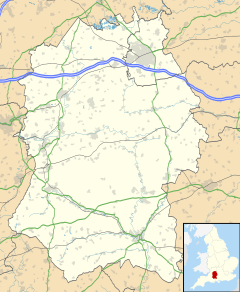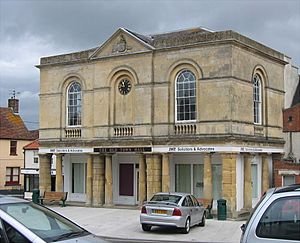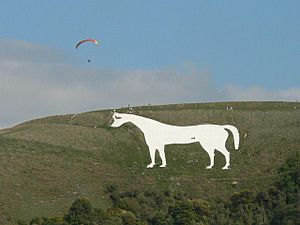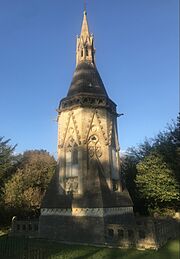Westbury, Wiltshire facts for kids
Quick facts for kids Westbury |
|
|---|---|
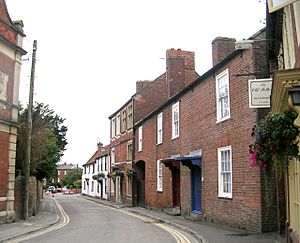 Church Street, Westbury |
|
| Population | 16,414 (2021 Census) |
| OS grid reference | ST868511 |
| Unitary authority |
|
| Ceremonial county | |
| Region | |
| Country | England |
| Sovereign state | United Kingdom |
| Post town | WESTBURY |
| Postcode district | BA13 |
| Dialling code | 01373 |
| Police | Wiltshire |
| Fire | Wiltshire |
| Ambulance | Great Western |
| EU Parliament | South West England |
| UK Parliament |
|
| Website | Town Council |
Westbury is a lively market town and civil parish located in the western part of Wiltshire, England. This town sits just below the northwestern edge of Salisbury Plain. It is about 4 kilometres (2.5 miles) south of Trowbridge and a similar distance north of Warminster.
In the 18th and 19th centuries, Westbury was famous for its yearly Westbury Hill Fair, where many sheep were sold. The town grew even more because it was located where two important railway lines met. Today, the busy A350 passes through Westbury, connecting the M4 motorway to England's south coast. The town has expanded to include the village of Westbury Leigh and the smaller areas called Chalford and Frogmore.
Contents
Westbury's History
Early Settlements and Old Westbury
Evidence of a Romano-British settlement was found at The Ham, in the north of the parish, back in the 1870s. This shows people lived here a very long time ago!
In 1086, the king owned the area of Westbury, including its main manor and the surrounding hundred (an old type of land division). The original Westbury parish was much larger, including places like Bratton, Dilton, Dilton Marsh, Heywood, and part of Chapmanslade. Churches in Bratton and Dilton were once smaller chapels connected to Westbury's main church.
Westbury's heart is its old marketplace, though markets stopped being held there in the mid-1800s. The town's main church is All Saints' Church. It was first built between 1340 and 1380. Parts of that old church still stand, but it was mostly rebuilt in the 1430s. During this time, new sections like a clerestory (upper windows), three chapels, and most of the central tower were added. The north chapel was a gift from William de Westbury and his father.
Westbury's Railway Connections
The Wilts, Somerset and Weymouth Railway reached Westbury in 1848. This railway company was bought by the Great Western Railway in 1850. Over the next few years, new lines were built from Westbury to places like Frome (to get coal), and south to Yeovil and Weymouth. A line was also built southeast from Westbury to Warminster and Salisbury.
Westbury station was rebuilt in 1899 because it was becoming a very important railway junction. In 1900, the Stert and Westbury line opened, creating a faster route from London to Weymouth. This new line crossed the route between the south coast and Bristol or South Wales right at Westbury. From 1906, trains from London to Taunton and Exeter also used this route.
Changes to Westbury's Boundaries
In 1894, the size of Westbury parish was made smaller. A new civil parish called Dilton Marsh was created from its western part. Likewise, Bratton parish was created from its eastern part. In 1896, Heywood parish was also created from the northern part of Westbury.
Westbury became an Urban District in 1899. This type of local government was removed in 1974. Westbury then became part of the West Wiltshire district. In 2009, this district was also removed, and Wiltshire Council became the main local authority for the area.
Leighton House, in the south of Westbury, has been home to the Army Officer Selection Board since 1949. This is where people are chosen to become officers in the army. The plan is for this board to move to Sandhurst by 2024.
Discovering Jurassic Fossils
A layer of Late Jurassic Kimmeridge Clay runs under England. This clay comes close to the surface around Westbury. Many amazing marine (sea) fossils have been found in pits dug for the cement works northeast of the town.
One very special discovery was an almost complete skull and a 1.8-metre (6-foot) lower jaw of a new species. This fossil was named Pliosaurus carpenteri after Simon Carpenter, who found it in 1994. This huge reptile-like ocean predator's fossil is now kept at Bristol Museum. A smaller fossil found in 1980 was named Pliosaurus westburyensis in 1993.
Westbury's Industries: Past and Present
Like other towns in the Avon valley, Westbury was a centre for making cloth from the late 1400s. By the early 1800s, Dilton Marsh was known for hand-loom weaving. The Phipps family were important cloth makers and became the biggest landowners by the end of the 1800s.
Over the 19th century, the cloth industry slowly disappeared. Only two mills, Angel and Bitham, continued to make fine woollen cloth. These mills closed in 1969. There were also businesses that did tanning (making leather) and glove-making. Some of these even took over the old cloth mills for a while in the 20th century.
Making malt (for brewing) was another important industry from at least the 1600s. In the 1830s, six companies were active in Westbury and Westbury Leigh. By 1960, only one remained.
Iron ore was found just north of the town in the 1840s when the railway was being built. Opencast mines (where minerals are dug from the surface) were developed, and furnaces were built. Iron production decreased towards the end of the century and stopped by 1925. A series of lakes and ponds near The Ham show where these old workings used to be.
What Does Westbury Mean?
The most likely reason for the West- in Westbury is simply that the town is near the western edge of Wiltshire. The borders of Wiltshire have been mostly the same since the Anglo-Saxon period.
The -bury part of the name comes from borough, which means a hill or a fortified town. In Wiltshire, -bury often points to an Iron Age or Bronze Age fortified hill fort. There is indeed such a site right above the Westbury White Horse.
How Westbury is Governed
Most local government services in Westbury are handled by Wiltshire Council. This includes things like schools, roads, social services, and waste disposal. The Westbury parish is divided into three areas, and each area elects one person to Wiltshire Council.
Westbury also has its own civil parish and an elected town council with fifteen members. The town council helps with local services and gives advice on important decisions. The head of the council is called the Mayor of Westbury, which is a special ceremonial role. Around 2020, the town council started managing the town's play areas, public toilets, and flower planting. They also run the Laverton Institute, which is a historic building used as the town hall and for events.
Westbury used to have its own parliamentary constituency (an area represented by an MP) called Westbury. However, in 2010, the name changed, and the town became part of the new South West Wiltshire constituency. Andrew Murrison from the Conservatives has been the Member of Parliament for this area since 2001.
Before the mid-1800s, Westbury was known as a "pocket borough." This meant that very few people could vote, and the owners of the parliamentary borough had a lot of control. Because of this, they sometimes gave gifts to the town, like the Old Town Hall in the Market Place, which was donated by Sir Manasseh Masseh Lopes.
Westbury's Location and Layout
Westbury is in the far west of Wiltshire, very close to the border with Somerset. It sits just below the northwestern edge of Salisbury Plain. Sometimes, people used to call it Westbury-under-the-Plain to tell it apart from other towns with the same name.
The town is about 29 kilometres (18 miles) southeast of the city of Bath. It is also about 4 kilometres (2.5 miles) south of the county town of Trowbridge and the same distance north of the army town of Warminster. Nearby villages include Bratton, Chapmanslade, Dilton Marsh, Edington, Heywood and Hawkeridge, Coulston, and Upton Scudamore. In Somerset, you can find Rudge and Standerwick.
The Biss Brook, which later becomes the River Biss as it flows north towards Trowbridge, forms most of the western border of the parish.
Parts of Westbury that have grown over time include Frogmore, Bitham Park, and The Ham (to the north and east). To the southwest, you'll find Chalford, Leigh Park, and Westbury Leigh. Westbury Leigh is sometimes seen as a separate village, with its own church and chapel, but it is now connected to the main town. Leigh Park is a large housing area built from the late 1990s. It has a big medical centre, a community hall, and a small shopping area with a Tesco Express.
Westbury's Economy
Until the 1940s, the Westbury Hill Fair was a very important yearly event, mainly for selling sheep.
In 1962, the company that became Blue Circle built a cement factory northeast of the town. This factory was connected to the railway. For a short time, its two rotary kilns (large ovens) were the biggest in the country! Chalk came from a quarry about 2 kilometres (1.2 miles) away, and clay was dug from pits near the factory. From 1977 to 1992, some of the factory's fuel came from household rubbish, and from 2000, old tyres were burned.
A French company called Lafarge took over Blue Circle in 2001, and cement production stopped in 2009. Most of the factory was taken down in 2016, but the cement silos (storage towers) are still used as a distribution centre. Since 2013, this centre has been owned by Tarmac. From 1961 until it was taken down in 2016, the factory's 122-metre (400-foot) chimney was the tallest unsupported structure in southwestern England.
Businesses in the Brook Lane industrial area, northwest of the railway station, include an Arla creamery that makes Anchor butter. The West Wilts trading estate, just northwest of Westbury in Heywood parish, is home to Welton Bibby & Baron. They say they are the UK's largest maker of paper bags and similar products.
Famous Landmarks in Westbury
Pevsner, a famous architectural historian, noted that the best houses in Westbury are found near the church. He described the 1960s central shopping area, which has two yellow brick buildings facing each other. He also mentioned the former Barclays Bank building from 1970, made of purple brick in a strong, modern style.
Besides the beautiful All Saints' Church, which is a Grade I listed building, Westbury has five Grade II* listed houses and one monument. The oldest of these is Ferndale House, now the Conservative Club, just east of the Market Place. Although it has been changed over time, it dates back to the early 1700s. It is made of brick with a special coating.
North of the Market Place, Bank House is an early 18th-century house made of red brick with stone details. Its front has five sections, with a carved stone shell design over the central door.
In the centre of the Market Place, the former town hall was built in the early 1800s. It is made of Bath stone and has a colonnade (a row of columns) at street level. Shops were added behind these columns in the 1970s. The windows on the first floor have decorative railings below them. Above these, the triangular pediment has the Lopes family coat of arms.
Edgar House, located off Edward Street south of the town centre, is an early 18th-century house that was remodelled from an older building. It is covered in stucco (a type of plaster). The Grade II* monument is the Phipps mausoleum in the cemetery, on the Bratton road on the eastern edge of the town. This stone monument, built around 1871, has a basement, an octagonal (eight-sided) room with four windows, and a short spire with a lantern (a small structure with openings for light).
The Westbury White Horse
A very famous sight in the area is the Westbury White Horse. This huge horse shape is carved into the hillside and overlooks the town from a slope leading up to Salisbury Plain. It is located in Bratton parish, about 2.4 kilometres (1.5 miles) east of Westbury.
The White Horse was probably first made in the 1700s. Its current shape dates from 1778, when it was repaired. In the 1950s, people decided it would be easier to keep the horse looking good if it was set in concrete and painted white.
Getting Around Westbury
Roads in Westbury
The A350 road goes through Westbury. This road offers a quick route to the M4 motorway (junction 17), which is about 34 kilometres (21 miles) to the north. There was once a plan for a Westbury Bypass to reduce traffic in the town. However, this plan was rejected in 2009 because it would have negatively affected the landscape east of the town.
Westbury's Railway Connections
Westbury is a very important railway junction. It is where the Reading to Taunton line (connecting London Paddington to Penzance) crosses the Wessex Main Line (linking Bristol and Bath Spa to Salisbury, Southampton, Portsmouth, and London Waterloo).
Westbury railway station is located northwest of the town centre. A smaller station, Dilton Marsh, is southwest of the town centre. This station is a request stop, meaning trains only stop there if someone asks to get on or off.
Education in Westbury
Westbury has one secondary school, two primary schools, a junior school, and an infants school. Matravers School is the secondary school, and it also has a sixth form for older students. It serves Westbury and nearby villages like Chapmanslade, Bratton, Dilton Marsh, and Edington.
Westbury Leigh C of E Primary School moved from Westbury Leigh to the nearby Leigh Park estate. Bitham Brook Primary School mainly serves the western part of the town. Westbury C of E Junior School is for children from Year 3 to Year 6 and is fed by Westbury Infant School, which teaches children from Reception to Year 2.
The closest college for further education is Wiltshire College's Trowbridge campus, about 7 kilometres (4.5 miles) north. The college also offers adult education classes at the Westbury Community Project building. The University of Bath is about 29 kilometres (18 miles) northwest.
Places of Worship
Church of England Churches
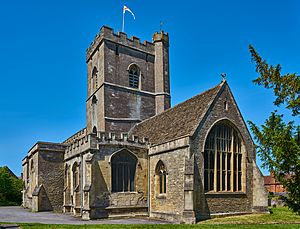
All Saints' Church is a Grade I listed building. It was first built in the 14th century but was changed and made bigger around 1437. It was then restored in 1847. Even though it is in a central spot near the market-place, other buildings hide it from view, except for its central tower.
St Mary's Church, Old Dilton was started in the 14th century. It stopped being used regularly in 1900 because fewer people lived in that area, southwest of Westbury. This Grade I listed building is still a consecrated church and has been looked after by the Churches Conservation Trust since 1974.
The Church of the Holy Saviour at Westbury Leigh was built in 1877 as a chapel of ease (a smaller church for people who live far from the main parish church). The south aisle was added in 1889, and the tower in 1890. All these parts were built using honey-coloured limestone, designed by the Gothic Revival architect William White. In 2000, the main part of the church was separated and turned into a community hall.
Other Religious Sites
Nonconformists (Protestants who were not part of the Church of England) started meeting in Westbury in 1662. They built a chapel on Warminster Road after 1711, which was rebuilt in 1821 to hold 500 people. It became a United Reformed Church in 1972.
There has been a strong Baptist community in Westbury Leigh. An early chapel was made from a barn in 1714. This was replaced in 1797 by a new chapel on the same site, built to hold 500 people. It was improved and made bigger in the next century. In 1810, another chapel was built nearby at Penknap in Dilton Marsh parish, after a disagreement in the congregation. The older chapel stopped being used before 2019. The Penknap building is still used today as Providence Baptist Church. Later, there was a Baptist community in Westbury itself. In 1868, they rebuilt their West End chapel to seat 350 people, on the site of a smaller chapel from the 1820s.
A Methodist church and schoolroom were built in 1926 at the town end of Station Road. This replaced a smaller chapel from around 1809. Today, it is used as a meeting place and event venue by local groups.
The Catholic Church of St Bernadette of Lourdes in West End, Westbury, was built in 1938. It is now served by the church of St John the Baptist in Trowbridge.
Sports and Fun in Westbury
Westbury Swimming Pool is one of the oldest Victorian swimming pools still in use in the country! Work on the pool started in 1887 by William Laverton, and his wife laid the foundation stone. The pool was a gift to the town of Westbury and opened on May 24, 1888, to celebrate Queen Victoria's Jubilee.
Westbury has a Non-League football club called Westbury United. They play at the Meadow Lane ground in the Southern League (the eighth level of English football).
The non-league Rugby Football Club, Westbury RFC, has both male and female teams. They play at the White Horse Country Park, a large 247-acre estate. This park also has a 9-hole Golf Course, a Driving Range, a Bowls Club, and Fishing Lakes. The park hosts shows and events throughout the year, including the Donkey Derby, Vintage & Classic Car Shows, and Christmas Concerts.
A cricket field at Wellhead Lane was created by the Laverton family, who owned mills. It became known as W. H. Laverton's Ground. In 1890, the famous cricketer W. G. Grace played there. Today, the ground is home to Westbury & District Cricket Club. Next to it is the Leighton Recreation Centre, which offers health and fitness suites, grass pitches, squash courts, tennis courts, and grass cricket pitches.
Westbury in the Media
Westbury has a free newspaper published every two weeks called the White Horse News. It is named after the famous White Horse on the edge of the town. The newspaper is delivered to homes in Westbury and nearby villages like Bratton, Dilton Marsh, and Edington. Westbury is also served by the weekly Warminster Journal and Wiltshire Times.
Local news and television programmes are provided by BBC West and ITV West Country. Television signals come from the Mendip TV transmitter.
Local radio stations include BBC Radio Wiltshire, Heart West, Greatest Hits Radio South West (which used to be The Breeze), and Warminster Community Radio (WCR), a local station that broadcasts from Warminster.
Notable People from Westbury
- William de Westbury (around 1385–1448/49) was a judge. He and his father built the north chapel of All Saints' church and provided money for it.
- Matthew Ley (1545–1636) and his brother James owned land in Brembridge and Heywood. Matthew was an MP for Westbury, and James became a very important government official.
- John Cogswell (1592–1669) was a merchant from Westbury Leigh who became a politician after moving to North America.
- Thomas Phipps (around 1648–1715) was a merchant who bought Dilton manor and Heywood House. His son, William (around 1681–1748), was the Governor of Bombay (now Mumbai) between 1722 and 1729.
- Phipps' family later owned the Leighton estate. His grandsons, John Lewis Phipps (1801–1870) and Charles Paul Phipps (1815–1880), built a successful business importing coffee from Brazil. Charles bought Chalcot House nearby and was also an MP for Westbury.
- Bryan Edwards (1743–1800) was born in Westbury. He owned plantations in Jamaica and supported the slave trade.
- Joshua Marshman (1768–1837) was a Baptist missionary who went to India.
- Abraham Laverton (1819–1889) was a mill owner and Member of Parliament for Westbury. He was a kind person who donated many buildings to Westbury, like the Laverton Institute.
- George Laverton (1888–1954) was a cricketer.
- Charles Nicholas Paul Phipps (1845–1913) was another coffee merchant and Member of Parliament for Westbury.
- Ruth May Fox (1853–1958) was born in Westbury but grew up elsewhere. She became an important women's rights activist in Utah, USA.
- Vernon Bartlett (1894–1983) was a journalist, author, and independent Member of Parliament.
- Penleigh Boyd (1890–1923) was an Australian painter.
Images for kids
See also
 In Spanish: Westbury (Wiltshire) para niños
In Spanish: Westbury (Wiltshire) para niños


